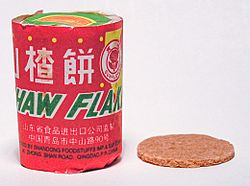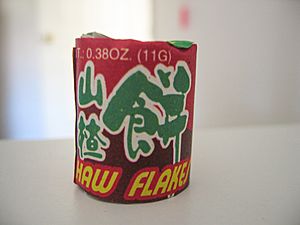Haw flakes facts for kids

A packaged stack of haw flakes and a haw flake
|
|
| Alternative names | Shān Zhā Bǐng |
|---|---|
| Type | Confectionery |
| Place of origin | China |
| Main ingredients | Chinese hawthorn fruit, sugar |
| Haw flakes | |||||||||||||||
|---|---|---|---|---|---|---|---|---|---|---|---|---|---|---|---|
| Traditional Chinese | 山楂餠 | ||||||||||||||
| Simplified Chinese | 山楂饼 | ||||||||||||||
|
|||||||||||||||
Haw flakes (Chinese: 山楂餠; pinyin: shānzhā bǐng) are a popular sweet treat from China. They are made from the fruit of the Chinese hawthorn tree. These candies are usually light or dark pink and shaped like small, flat discs.
You'll often find them packaged in tall, round stacks. The wrappers sometimes look like Chinese fireworks! Haw flakes have a yummy sweet and tangy taste. People often serve them to guests with tea, or kids enjoy them as a special snack. Some Chinese people even eat them with bitter herbal medicine to help with the taste.
Types of Haw Flakes
You can find different kinds of haw flakes. Some special Chinese stores in Western countries sell "gourmet" haw flakes. These are usually bigger than the regular ones.
For example, regular haw flakes from the Shandong region are about 25 millimeters wide. But the gourmet ones can be much larger, around 35 to 40 millimeters across! In China, you can also easily find haw flakes with less sugar or no extra ingredients. These are made for people who want a healthier snack. Their color can be from a light beige to a reddish-brown.
Food Safety Rules
Different countries have different rules about what can be added to food. Sometimes, haw flakes have been stopped from entering the United States. This happened because they contained a certain artificial coloring called Ponceau 4R.
Ponceau 4R is allowed in places like Europe, Asia, and Australia. However, the United States Food and Drug Administration (FDA) does not approve it for use in foods there. Today, some brands of haw flakes use a different red coloring called Allura Red AC. In Europe, it's suggested that children should not eat too much of this coloring. This food coloring was once not allowed in Denmark, Belgium, France, and Switzerland.
See also
In Spanish: Escamas de espino para niños


